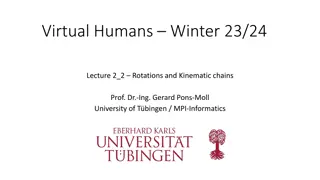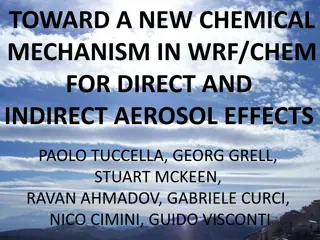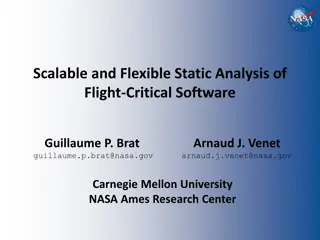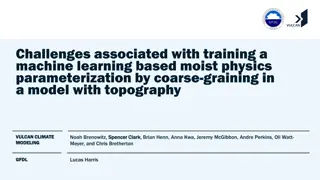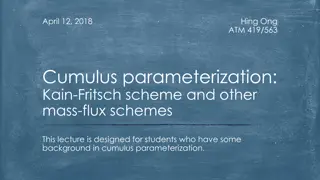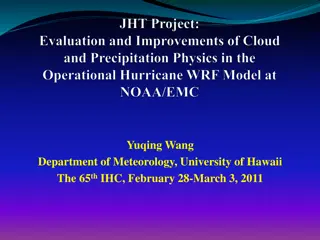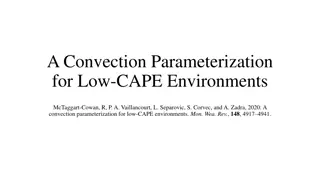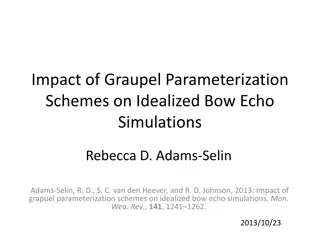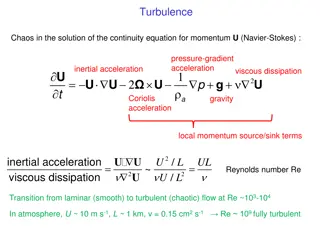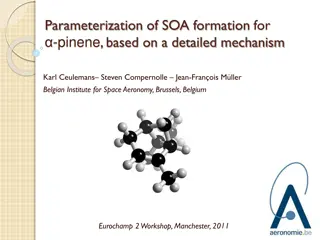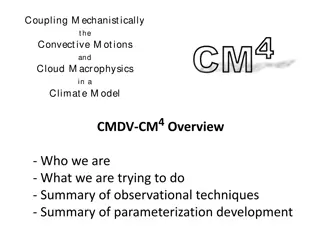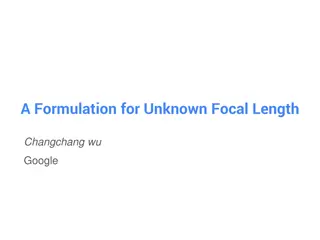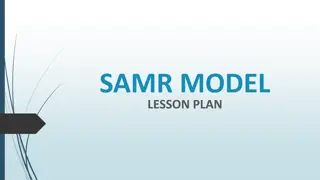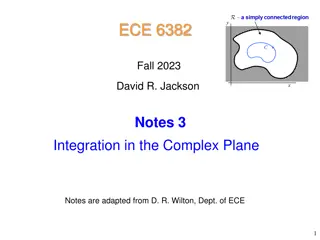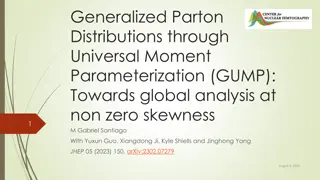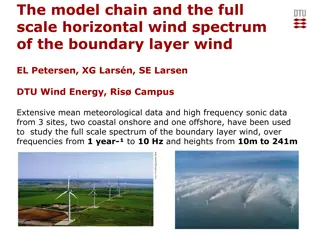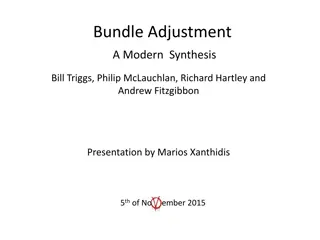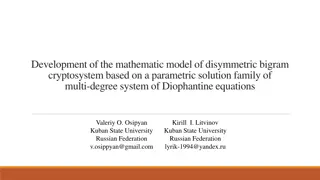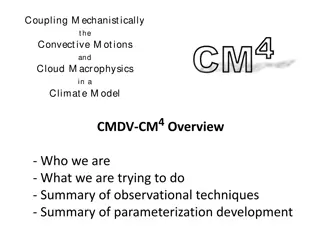Rotations and Kinematic Chains in Virtual Human Modeling
Exploring the concept of rotations in transformations and the use of kinematic chains in modeling human motion. Topics covered include kinematic parameterization, optimization of rigid body motions, and building virtual human models through kinematic chains. Understanding rotations as linear transfo
9 views • 78 slides
Enhancing Ecological Sustainability through Gamified Machine Learning
Improving human-computer interactions with gamification can help understand ecological sustainability better by parameterizing complex models. Allometric Trophic Network models analyze energy flow and biomass dynamics, but face challenges in parameterization. The Convergence Game in World of Balance
3 views • 12 slides
Parameters and Objects in Java Programs
Explore the concepts of parameters and objects in Java programming, including examples of redundant recipes, a parameterized recipe, and a redundant solution. Learn how parameterization can streamline coding by passing values to methods, improving code efficiency. Discover the importance of variable
1 views • 24 slides
Advancements in Chemical Mechanisms for Aerosol Effects in WRF/Chem Model
This study focuses on the development of a new chemical mechanism in the Weather Research and Forecasting with Chemistry (WRF/Chem) model to address the underestimation of carbonaceous aerosols. The RACM/MADE/SOA-VBS mechanism incorporates advancements in gas-phase chemistry and particle parameteriz
0 views • 12 slides
Static Analysis in Flight-Critical Software
Explore the challenges and advancements in static analysis for flight-critical systems, focusing on the importance of soundness and assurance through tools like IKOS, MathWorks PolySpace, and ASTREE. Learn about the limitations of testing in detecting critical errors and how static analysis can offe
0 views • 23 slides
Challenges in Training Machine Learning Parameterization for Climate Modeling
This project aims to enhance rainfall predictions in global climate models by training a machine learning-based parameterization using coarse-graining techniques. By utilizing output from a high-resolution storm-resolving model, the goal is to improve accuracy without the high computational cost ass
1 views • 24 slides
Cumulus Parameterization and Mass-Flux Schemes in Atmospheric Science
Explore the significance of mass-flux schemes in cumulus parameterization, their interaction with grid-scale microphysics, and the key elements and assumptions involved. Learn about the objectives, components, and limitations of classical cumulus schemes for atmospheric modeling. Gain insights into
3 views • 23 slides
Evaluation and Improvement of Cloud and Precipitation Physics in Hurricane Weather Forecasting
Yuqing Wang from the Department of Meteorology at the University of Hawaii worked on evaluating and enhancing cloud and precipitation physics in the operational Hurricane Weather Research and Forecast (HWRF) model. The project aimed to improve hurricane intensity and structure predictions, focusing
3 views • 18 slides
Convection Parameterization for Low-CAPE Environments
Many global Numerical Weather Prediction systems face challenges predicting convective activity in low-CAPE environments. This study introduces a convection parameterization scheme based on moisture convergence to better represent convective effects. The scheme focuses on the triggering function, up
5 views • 38 slides
Impact of Graupel Parameterization Schemes on Bow Echo Simulations
The study explores the impact of graupel parameterization schemes on idealized bow echo simulations, focusing on the role of the cold pool in shaping storm structure and longevity. Changes in microphysical characteristics, cold pool strength, and vorticity balance are examined using a cloud-resolvin
0 views • 23 slides
Turbulence in Fluid Dynamics: A Comprehensive Exploration
Exploring the complexities of turbulence in fluid dynamics, from the Navier-Stokes equations to subgrid transport and turbulent diffusion. Insights into the transition from laminar to turbulent flow, subgrid scale importance, and treatment of small-scale eddies are discussed. The impact of turbulenc
2 views • 9 slides
SOA Formation for α-Pinene Using Detailed Mechanisms
This content discusses the parameterization of secondary organic aerosol (SOA) formation for α-pinene based on a detailed mechanism, outlining the BOREAM model for simulations, incorporating explicit and generic chemistry. Various experiments and simulations in smog chambers are analyzed, revealing
2 views • 21 slides
Coupling of Convective Motions and Cloud Macrophysics in Climate Model CMDV-CM4
This project led by Lawrence Berkeley National Laboratory aims to mechanistically couple convective motions and cloud macrophysics in the CMDV-CM4 climate model. Through observational techniques and parameterization development, they seek to evaluate and enhance current cloud representations, develo
1 views • 16 slides
A Formulation for Unknown Focal Length
A detailed exploration of solving for unknown focal length in camera pose estimation problems, addressing redundancies, introducing a new parameterization method, and discussing novel applications. The formulation allows for more efficient and accurate solutions in scenarios with varying complexitie
4 views • 7 slides
Constraining Significant Variation in Orographic Drag Representation
Model orography intercomparison for drag parameterization in numerical weather prediction. Analyzing subgrid-scale mountains, stress sensitivity experiments, and the influence of various factors on global surface stress.
2 views • 16 slides
NCAR CAM Eulerian Dynamical Core
NCAR CAM Eulerian Dynamical Core, developed by Casey Oswant, is the main component in Version 5 of the NCAR atmospheric global climate model. It cleanly separates the dynamical core and parameterization suite, facilitating easier modifications. The model utilizes a hybrid vertical coordinate, follow
2 views • 19 slides
Integration in the Complex Plane: Definitions and Equivalences
Learn about line integrals in the complex plane, equivalence between complex and real line integrals, and review of line integral evaluation. Understand how to evaluate line integrals using parameterization and examples.
1 views • 53 slides
Economics in Tech
Delve into the world of Turbulent Flows with a focus on Large Eddy Simulation (LES). Explore Eddy Viscosity Models, including the analogy to molecular viscosity and the parameterization of SGS eddy-viscosity. Discover the implications of different eddy-viscosity models on Reynolds number and energy
3 views • 11 slides
Generalized Parton Distributions through Universal Moment Parameterization: Towards Global Analysis
This research focuses on the GUMP method for analyzing Generalized Parton Distributions at non-zero skewness. The study, led by M. Gabriel Santiago and team, utilizes universal moment parameterization to advance global analysis in high-energy physics.
3 views • 27 slides
Overview of Physics Representations in Weather Prediction Models
An overview of physics representations in numerical weather prediction models, including parameterization of diabatic forcing, clouds, radiation transfer, sub-grid mixing, and surface property transfer.
1 views • 32 slides
Full-Scale Spectrum of Boundary Layer Wind: Insights from Data Analysis
Studying the full-scale spectrum of boundary layer wind using extensive meteorological and sonic data from various sites reveals insights into spectral behaviors at different scales. This analysis aids in building robust models and understanding the crucial spectral gap between 2D and 3D atmospheric
4 views • 18 slides
IEEE 802.11-15/0105r0 Spatial Reuse Management Overview
This document from January 2015 discusses the various approaches to spatial reuse in IEEE 802.11-15/0105r0, focusing on dynamic sensitivity control and adaptive CCA thresholds. The authors present different versions of spatial reuse, highlighting the need for parameterization and configurability by
6 views • 9 slides
Enhancing JULES-ES: Community Input Needed for Future Developments
Explore the upcoming enhancements to JULES-ES for better permafrost modeling, including updates to soil parameterization, water fluxes, and more. Join the Northern High Latitudes Group to contribute to running and developing JULES in these regions. Contact Eleanor Burke for involvement opportunities
3 views • 4 slides
Assessment of Mesoscale Eddies Impact under Climate Change
This study assesses the impact of mesoscale eddies on large-scale physical and biogeochemical responses under climate change. Through a GM-based GEOMETRIC parameterization, the research examines the effects on nutrient streams and net primary productivity. Significant improvements in physical respon
1 views • 9 slides
Bundle Adjustment: A Modern Synthesis in Computer Vision
Explore the concept of bundle adjustment for refining visual reconstructions and optimizing 3D structures with viewing parameters. Learn how it applies to robotics and the challenges of geometric parameter estimation in computer vision. Dive into error modeling and projection parameterization for ef
1 views • 18 slides
the ACME Single Column Model in Atmospheric Research
Discover the capabilities and challenges of the ACME Single Column Model (SCM) used in atmospheric science research. Learn how this tool aids in model parameterization development and assessment, as well as the improvements made to address aerosol concentration initialization issues.
0 views • 11 slides
Optimizing Ad Hoc Network Capacity: Limits and Achievable Rates
Explore the fundamental limits of ad hoc network capacity, including achievable rate regions and cross-layer design concepts. Delve into the Shangri-La of Information Theory and the pursuit of wireless network capacity limits. Dive into various network capacity results and questions surrounding para
5 views • 34 slides
Tuning ANNs for Improved Performance
ANNs face challenges like over-parameterization and non-convex optimization. Learn how to optimize ANN models with considerations in starting values, avoiding overfitting, and selecting hidden units. Discover the impact of starting values, likelihood of overfitting, weight decay, and scaling inputs
2 views • 43 slides
Tuning Artificial Neural Networks: Considerations and Solutions
When fitting an Artificial Neural Network (ANN) model, various considerations such as over-parameterization and non-convex optimization arise. Addressing these issues involves selecting appropriate starting weights, avoiding overfitting, and determining the number of hidden units and layers. The imp
3 views • 47 slides
Mathematical Model of Disymmetric Bigram Cryptosystem Development
Explore the development of a mathematical model for a disymmetric bigram cryptosystem using parametric solutions of multi-degree Diophantine equations. Learn about the Diophantine equation system, solutions properties, and parameterization method for multi-degree systems. Dive into the proposed cryp
2 views • 9 slides
Low-Frequency Properties and Parameterization of Layered Medium - ORT Interpretation
Explore the low-frequency properties of a layered medium, including ORT stiffness coefficients, system matrix, upscaling techniques, and the BCH series. Understand dispersion in terms of ORT parameters and zero-frequency approximation for physical mediums. Discover insights by Alexey Stovas and IGP
3 views • 21 slides
Mechanistic Coupling of Convective Motions and Cloud Macrophysics
Explore the integration of convective motions and cloud macrophysics in the CMDV-CM4 climate model through observational techniques and parameterization development at Lawrence Berkeley National Laboratory. This project aims to improve the representation of shallow clouds, evaluate current models, a
3 views • 16 slides
Parameter Sniffing and Query Optimization
In this insightful content, Benjamin Nevarez explores the intricacies of parameter sniffing, the Query Optimizer, and various aspects of parameterization in SQL Server. Dive into the world of query plans, plan reuse, and the impact of parameter values on query performance. Gain a deeper understandin
0 views • 22 slides
Parameter Sniffing and Query Optimization
In this content, Benjamin Nevarez discusses the concepts of parameter sniffing, query optimization, and parameterization in SQL Server. He explains the purpose of the query optimizer and procedure cache, different types of parameterization, and provides examples of explicit and implicit parameteriza
0 views • 9 slides
Parameter Sniffing Insights
Speaker Benjamin Nevarez discusses the Query Optimizer's purpose in analyzing and selecting execution plans, the Procedure Cache's role in caching query plans for reuse, and the importance of Parameterization in optimizing query performance. Learn about different types of Parameterization and their
0 views • 14 slides
Generic Algorithms in C++: Evolution from Basic to Advanced Concepts
This content delves into the evolution of generic algorithms in C++, starting from basic linear search methods to advanced implementations using ranges and generic iterators. The progression showcases how the algorithms have been refined and abstracted, maintaining their fundamental structure while
3 views • 27 slides
Disymmetric Bigram Cryptosystem Mathematical Model & Solutions
Explore the development of a mathematical model for a disymmetric bigram cryptosystem based on parametric solutions of Diophantine equations. Delve into properties and parameterization methods for multi-degree systems, as well as the cryptosystem's structure and encryption algorithms.
1 views • 9 slides
Lexicalized Parsing in NLP: Limitations and Solutions
Explore the limitations of Probabilistic Context-Free Grammars (PCFGs) in Natural Language Processing (NLP) and how lexicalized parsing addresses these challenges. Dive into issues with lexicalized grammars, including sparseness of training data and combinatorial explosion, alongside solutions like
1 views • 18 slides
Challenges in Subsurface Modeling: Estimation of Distributed Parameters at Regional Scale
Explore modern challenges in deterministic and stochastic subsurface modeling across multiple scales focusing on the estimation of distributed parameters in a multi-layered sedimentary aquifer. The study presents a novel approach using the Gauss-Marquard-Levenberg algorithm to optimize parameterizat
3 views • 20 slides
Python Functions with Parameters and Graphics
Learn how to define Python functions with multiple parameters and create graphics using stars as elements. Explore examples of functions accepting multiple parameters and using string inputs, along with modifying the stars program to draw boxes. Enhance your understanding of function parameterizatio
0 views • 26 slides
